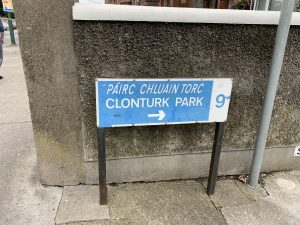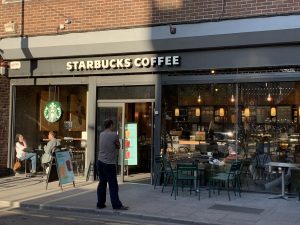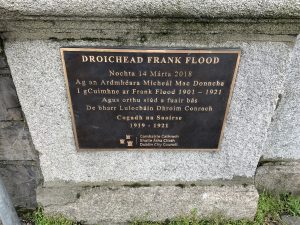Taking public transportation from the suburbs into downtown Dublin always gives me the impression that the city is multilingual. Farther away from the city, I pass signs that are exclusively in Irish. Other street signs and bus terminals feature both English and Irish text, and as I make my way downtown, I hear each upcoming bus stop announced in both languages. Sometimes the Irish is even above the English, suggesting one language doesn’t dominate the other. But once I get off the bus, the Irish practically disappears. While street signs remain multilingual, nearly every company logo, storefront sign and advertisement I see is in English, and the city center is reminiscent of any commercial center in the United States or tourist hub around the world.
What does this say about downtown Dublin’s linguistic landscape? The fact that most uses of Irish are on public materials, like street signs or buses and trains, suggests that the government is involved in promoting the use of the Irish language in the city. Indeed, political processes are one of the three processes that contribute to a city’s linguistic landscape, according to Leeman & Modan (2009). Irish is also prevalent in government operations themselves. When I go to parliament hearings, all of the officials are referred to by their Irish titles, and even the parliament building is called by its Irish name, the Oireachtas. It’s possible that government officials, who tend to be more patriotic than the average citizen, are using their influence to preserve or promote the Irish language as its everyday use decreases.

But given that the social and commercial landscape is almost exclusively in English, it appears that the social and economic forces — the other two processes that contribute to the linguistic landscape according to Leeman & Modan — have not commodified the Irish language in the private sector (Leeman & Modan, 2009). Every conversation I’ve had and most conversations I’ve overheard have been in English, and every menu I’ve looked at or storefront sign I’ve read have been in English, too. This makes sense because nearly everyone in Dublin speaks English, but less than 30% of Dublin city residents can speak Irish (“Census,” 2018). In fact, it seems like companies might intentionally use English to attract tourists and residents alike because it is more accessible and appealing to them than Irish would be.
This presents a stark contrast to the use of Chinese in Washington D.C.’s Chinatown. Leeman and Modan explain that the desire to preserve cultural tradition and heritage in the area and the “exotic” appeal of Chinese language and decorations pushed the government and private companies to keep Chinese in the linguistic landscape, even though most residents don’t speak Chinese. (Leeman & Modan, 2009) But Irish doesn’t seem to hold the same cultural appeal or reap the same economic benefits in an increasingly global city. For example, my favorite restaurant in Chinatown has Chinese writing on its sign even though it serves Mediterranean food, whereas even traditional Irish restaurants in Dublin operate primarily in English. Similarly, the Starbucks in Chinatown features Chinese writing, while the ones in Dublin — and in China, for that matter — only feature English (Leeman & Modan, 2009).

Though English dominates the city center, I wouldn’t consider Dublin a monolingual society because Irish is still present and becomes more noticeable in the outskirts of the city. This could be because the demographic composition of suburbs is “more Irish” than the downtown, so more people are familiar with the language. When I went to a performance at a nearby theater, about 5 miles from downtown Dublin, the emcee first welcomed everyone in Irish before repeating herself in English. Some school signs are only in Irish, and most students learn Irish, as well.

Based on what I’ve observed, it seems like the use of Irish in Dublin’s linguistic landscape is an attempt to preserve the culture of Ireland as it becomes a more diverse society. This is somewhat similar to the first wave of revitalization in Chinatown, which partially emphasized the inclusion of Chinese in the linguistic landscape for cultural and functional purposes (Leeman & Modan, 2009). While it seems to me like using Irish is antiquated, I’ve met people who feel differently. As the man who taught our group how to play traditional Gaelic football told us, there is nothing more important than preserving Irish culture — and that includes keeping Dublin a multilingual city.
Works Cited
Census of Population 2016 – Profile 10 Education, Skills and the Irish Language (2018). Central
Statistics Office. Retrieved from: https://www.cso.ie/en/releasesandpublications/ep/p-cp10esil/p10esil/ilg/
Leeman, J & Modan, G. (2009), Commodified language in Chinatown: a contextualized
approach to a linguistic landscape. Journal of Sociolinguistics, 13(3), 332-362.
Josh,
I enjoyed reading the part of your essay on the ties between the government and the Irish language. I found it interesting that, given the prevalence of English in Ireland, that the government would still attempt to promote the use of the traditional Irish language. The circumstances are certainly different here in Berlin. German is obviously the primary language here (though most people speak English as well). I’m left to wonder why the linguistic states of these two cities have diverged this way. Another question that I had has to deal with the United States; I wonder how people would react if the government took an active role in promoting a language other than English, such as Spanish or French. The current linguistic landscape in Ireland might allow for the phenomena that you describe in your essay, but I suspect that it would be quite different in America and in Germany.